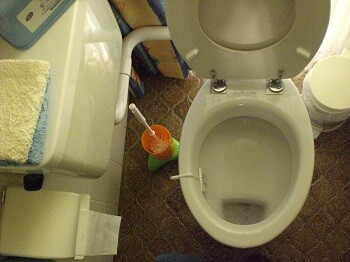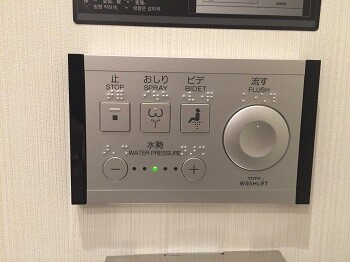4 Toilet Habits From Around The World (That Will Surprise The Average American)

Some time ago, we here at Cracked published a scathing sociological study into the state of America’s pee-pee and poo-poo bowls. And while, like the last sliver of toilet paper hanging from a roll, what we saw was disturbingly lacking, it’s not like the US is the only nation in the world that is waddling towards an uncertain sanitary future. Other countries have their own toilet cultures to cope with, and the only thing they seem to have in common is how weird everyone else thinks they are. For example...
In Germany, Toilets Aren’t Just For Pooping, But Inspection Of The Self
If inspecting these esoteric, traditionalistic, foreign and domestic sanitary habits tells us anything it’s good to take a good look at your toilet routines every once and a while. But there’s no need to make a habit out of it -- lest you end up with an overly rigid poop-inspection culture.
The Germanic peoples have a long history of being slightly obsessed with poop. That hasn’t just influenced how they look at medicine or money or music or God but even how they look at toilets themselves. Enter the Flachspüler or “shallow flusher,’ a type of German toilet that for centuries has caused upset for its tourists, ex-pats, and dialectic materialist philosophers.
Don't Miss
As opposed to the bullseye basins of Western European toilets or the above-ground swimming pools Americans insist on filling their toilets with, inside the Flachspüler toilet bowl is just more toilet bowl, with only a slight drainage opening at the front. So unless you can curve your turds like you’re in a deleted bathroom scene from the movie Wanted, your business will lounge around on the poop deck instead of immediately sailing down to the sewer. That’s the point. In and after the Middle Ages, central Europe had serious intestinal parasite problems. This encouraged Germans to get real casual real fast about handling and inspecting their poop. And since stool inspection is all about quantity over quality, it made sense to create a toilet that lets you do a quick doublecheck your Wurst to see if it’s time for a visit to the doctor.
After you send off your thoroughly inspected turd by pressing the Big Flush button (WHICH IS ONLY FOR NUMBER TWOS AND POSSIBLY NUMBER FIVES IF IN POSSESSION OF THE CORRECT PAPERS) the ritual still isn’t done. Unlike in every single guy’s bathroom, that alien personal massager-looking toilet brush next to the bowl isn’t just there for show. Keenly aware that skidmarks are the one (one) downside of the toilet shelf, German toilet etiquette insists that users clean the toilet after every single use, leaving it in the same sterile lab conditions as befits the next amateur scatologist.

Luckily, German Flachspülers are on the way out and becoming rarer and rarer to spot in modern buildings. Not that you should be spotting anything anyway. Another strict toilet rule that’s on the rise is that anyone entering a German toilet should immediately face away from the toilet and sit down on it. This has been a decade-long grassroots campaign to condition people with pee-pees to sit on the toilet even if they just have to go number one. This ruthlessly efficient attempt to eliminate loud peeing, inaccurate aiming, and splash back had even led to the creation of pressure-sensitive toilet seat alarms or “toilet ghosts” which very loudly haunt those who refuse to bend the knee.

Some Local Toilets Aren’t Equipped To Handle Toilet Paper
America and other sensitively bottomed industrialized nations are in a losing battle against fatbergs, the subterranean sludge titans borne of flushed wet wipes that are slowly scuttling their sophisticated sewer systems. But it turns out that dealing with subterranean sludge titans because people’s bum-bums are too sensitive for toilet paper is still a first-world problem.
As opposed to most toilet paper-heavy cultures, many parts of Mexico have a strict “no flushing TP” rule. Instead, ‘used’ scraps of toilet paper are to be discarded in a trash can like all the other scraps. The reason for this is obvious. Mexico isn’t exactly flush with sanitation funds -- and that public project money has an easier time finding its way into someone’s pocket than in their pipes. As a result, public sewer systems have such old and frail poop chutes they easily strain under the weight of a few wadded-up balls of paper. What’s less obvious is why Mexico, but also many other places like Greece, Beijing, Ukraine, and Egypt, have nevertheless clung to toilet paper like a shoe that knows its wearer is on the way to an important job interview.

But all of these countries have something else in common aside from having to handle their wastebaskets wearing Medieval plague beaks; they’re all victims of “sanitary imperialism.” As former colonies or poor neighbors of the U.S. and the UK, they were prime targets of these world powers’ push to make their pooping habits the world standard in the early twentieth century. Through world fairs, model homes and, most importantly, the moving pictures, the West threw its flush toilets ticker tape parades and touted them as one of the benchmarks of a civilized society. Unfortunately for those nations on the periphery of this influence sphere, America forgot to mention that their old sewer systems were in no way compatible with the new model -- thereby creating a double system far too expensive to adapt in either direction-- a unique kind of frustration felt only by the people of Mexico and anyone who has ever upgraded to a new Macbook.
Italy’s Public Bathrooms Are A Mess (Of Different Ideas)
While the state of American public toilets is nothing to brag about, at least you know what you’re going to get: An unflushed toilet, one strip of single-ply and so many gloryholes honeycombed into the stalls it no longer counts as anonymous sex. That reassuring consistency cannot be found in Italy, where public toilets are like a box of chocolates -- you never know what you’re going to get.
Stepping into an Italian public toilet is a bit of a crapshoot. Firstly, the chance of you walking into the correct one is about 50-50 since almost no bathrooms are furnished with signs. And in an act of language trolling, those who do will either read “Signore” or “Signori” so you better did some intense Duolingo’ing on the flight over. Once you’ve stepped through the door, the confusion doesn’t end. Locking an Italian stall is a challenge in itself with many still using old-fashioned keys or very oddly placed padlocks. And that’s if they close at all, as many tourist sites warn that there’s a good chance you’ll find the stall door with a busted lock or even with the door kicked in.
But for most Western tourists, the real horror kicks in when they turn to look at the toilet -- or lack thereof. A not-insignificant amount Italian restrooms will be un bagno alla turca which sounds like a nice day at a spa but is in fact their word for a squat toilet, the slightly decorated holes in the ground. Manage to find a flush toilet (one of the 44-ish different sized ones as the country has no standardization) and you’ll still not get to rest your bones. There's also a good chance the actual toilet seat will be missing meaning it’s time to hover like an Italian mother over her daughter-in-law’s subpar ragu.

This game of restroom roulette defies the expectations many people have of Italy. Not only does the European nation live on tourism, but its households are known for their elaborate personal bathrooms with bidets as glorious as the trumpets atop the Trevi fountain. It’s also a country that, lest we forget, has a long and proud history of pioneering public bathrooms that stretches back to when Ancient Italians vied for communal turd sponges and did some bathroom stretching of their own in front of friends, Romans and countrymen.

But it’s exactly this long, intermingling history that has caused Italy’s dump-diversity. The Mediterranean region couldn’t be more culturally and religiously diverse if they brought back Zoroastrianism (which had its own song and dance when it came to toilet regulations). As a result, like nearly two-thirds of humanity, the idea of rubbing your bare ass on a wood plank before dabbing your dirty cheeks with a thin napkin isn’t as ingrained into South Europeans as the rest of the continent.
So while many tourists sites will endlessly speculate why Italian bathrooms are so crap, often taking the lazy route by blaming it on laziness or corruption or even blaming the lack of toilet seats on tourists breaking them by squatting on bowls like guano gargoyles, the real reason is much simpler: Italians, and most of their visitors, don’t see anything broken toilets; they simply see toilets that don’t cater to the sensibilities of a very loud farting minority. Luckily, those insistent on sticking to their own tastes abroad can still find American-style toilets in either McDonald’s or the Vatican -- whichever they feel more comfortable riding out a grosso logjam.
Japanese High Tech Toilets Will Soon Rule The World
The best thing that happened to American toilet habits during the pandemic was the popularization of the bidet; its seductive sphincter sprays finally loosening toilet paper’s quadruple-ply stranglehold on the nation’s puritanical puckers. But the rise of the simple bidet may end as soon as it began, serving only as a stepping stone to the high-tech destroyer of Western toilet culture -- the futuristic Toto.

For the majority of its history, Japan had built a sophisticated hygiene culture around the typical Eastern squat toilets. This completely changed after World War II when the country shifted to porcelain bowl toilets in a literal attempt to unclench the buttholes of their American occupiers. But the microchip nation, not used to just sitting around when it comes to toilet tech, soon started tinkering their new toilets. And by 1980, Japan had transformed the flush toilet into the “washlet” in the same way they had transformed your standard long-haul rig into Optimus Prime.
Pioneered by Toto, the Apple of poop bowls, washlets are the reason everyone who visits Japan will show you a picture of their hotel toilets. These space-age privies are kitted out with endless features, from warmed seats to colored jets to sensor-activated flushes to built-in Otohime, “sound princesses” that play soothing sounds. Today, the consoles on the most advanced washlets contain so many symbols the Japanese toilet industry had to develop a standardized symbol language to minimize the risk of confused users accidentally spraying their buttholes with boiling disco water while playing “We Didn’t Start The Fire” at max volume.

But washlets aren’t designed to be gadgets, they’re designed to be the perfect poop-parsing machines. The Japanese toilet industry has spent the last half-century eliminating elimination inefficiency, figuring out the optimal waterjet angle for cleaning (exactly 43 degrees), the optimal flush pattern for water conservation (ring cascades) and even inventing ewater+, an acidified toilet water for optimal hygiene. Aside from being state of the art, washlets are also just art (they even have their own museum in Fukuoka) their designs resembling not so much an indoor crapper as an abstract minimalist sculpture you just so happened to plonk in the middle of your bathroom.
And being abstract is the real goal of the washlet, which is designed not only to offer the best toilet-going experience, but the least toilet-going experience. Japan has a long and not-so-proud history of being really embarrassed about bodily functions. To minimize users’ sense of shame, Toto designed the washlets to make using a toilet as invisible a process as possible. Its flushing system may save on water, but it was also designed to make a flush as quiet as possible. Its built-in soundscapes not only relax your pooping muscles, they’re there to mask the sound of your body noises which the Japanese used to do by constantly flushing water while doing their butt business -- a practice dating back to the “water dragons” of the Edo Period. And the sensor-activated toilet seats, body temp bidets, smart scent-spreaders, and auto-flush reduce user interaction so much you’ll almost forget you’re sitting in a cold smelly room pushing digested waste out of your anus.

So while it may seem that the Japanese have simply improved the Western way of the water closet, they have instead injected it with their own hygiene culture, one directly opposed to the dominant Everybody Poops philosophy. And like America’s sanitary imperialism of a century prior, the Japanese have set out to conquer the world. Their toilet industry has transformed every public and hotel toilet in the nation into aspirational pooping propaganda to convert tourists, a culture war that will have its blitzkrieg moment during the upcoming Tokyo Olympics. Between that and the unexpected bidet craze of the past year, it seems like only a matter of time before we all become subjects of Japan’s Empire of the John.
For more toilet tangents, do follow Cedric on Twitter.
Top Image: Caromco, Amazon / Secretlondon23, Flickr